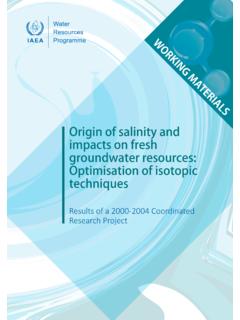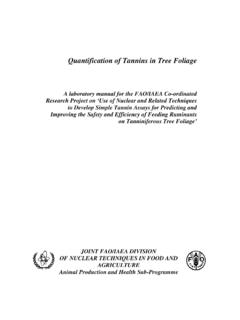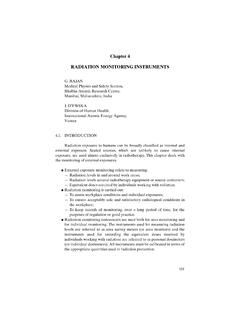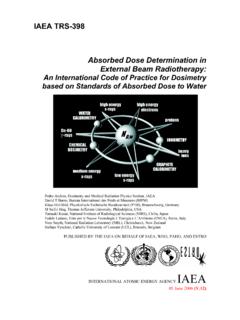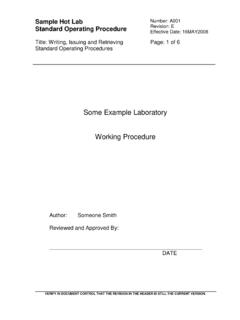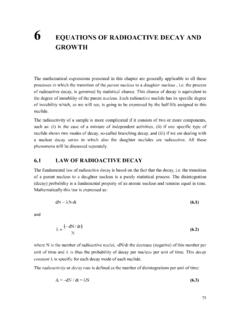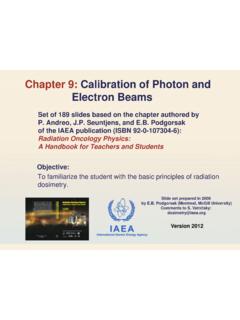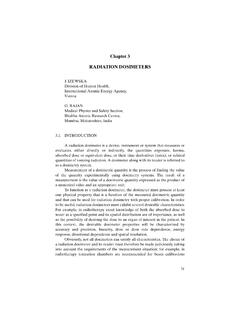Transcription of 10 CHEMISTRY OF CARBONIC ACID EQUILIBRIA IN WATER
1 9 CHEMISTRY OF CARBONIC ACID IN WATER INTRODUCTION Studying the carbon isotopic composition of WATER , whether it concerns freshwater or seawater, a complication arises from the fact that the dissolved inorganic carbon always consists of more than one compound, while also the presence of gaseous CO2 and solid calcium carbonate may be relevant. In fact we are dealing with the following compounds and concentrations : gaseous CO2 (occasionally denoted by CO2g) with a partial pressure PCO2 dissolved CO2 (denoted by CO2aq) dissolved CARBONIC acid, H2CO3 with a = [H2CO3] + [CO2aq] dissolved bicarbonate, HCO3 with b = [HCO3 ] dissolved carbonate, CO32 with c = [CO32 ] total dissolved inorganic carbon, DIC, with CT = a + b + c solid carbonate, CaCO3 (occasionally denoted by s) The ambiguity in using carbon isotopes now consists of two observations.
2 1) On the one hand, only the isotopic composition of a single compound in relation to that of another compound is geochemically or hydrologically meaningful. We have seen an example of this statement while discussing the carbon isotopic composition of groundwater , for 13C as well as 14C ( and ). In other words: an isotopic fractionation factor is a fundamental, physico/chemical quantity only if it is the ratio between two isotopic ratios of single compounds. For instance: 13 a/b = 13Ra/13Rb and 13 c/b = 13Rc/13Rb 2) a) On the other hand, in mass balance considerations the carbon isotopic composition of a mixture of compounds is relevant.
3 For instance, if CO2 or CaCO3 are being removed from a dissolved carbon solution, of for estuarine mixing of fresh- and seawater, the total 13C mass balance has to be taken into account. In this chapter some examples are given. b) Measuring the carbon isotopic composition of a solution comes to extracting the total CO2 from the sample after acidification, instead of single compounds. For the essential translation of 13 of total dissolved carbon to 13 of single compounds, and conversely, the inorganic carbon CHEMISTRY , of the dissolved inorganic carbon is required.
4 143 Chapter 9 Once the various concentrations of the dissolved species -to be deduced in the next sections are known, the 13C mass balance: 3CO13233 HCO1333CO2H1332aq2CO132 DIC13233322R]CO[R]HCO[R]COH[R]aqCO[R]CO[ ]HCO[]COH[]aqCO[ ( ) or, inserting the previously mentioned symbols for the various concentrations and combining the concentration of CO2aq and the CARBONIC acid, H2CO3, the latter being a negligibly small fraction, the isotopic composition of the total dissolved carbon (CT = a + b + c) is: TcbaTC13 CRcRbRaR ( ) and conversely, inserting the proper fractionation factors as mentioned before: bcbaRCRb/cb/aTC13Tb13 ( ) The next sections will be devoted to analysing the chemical composition of carbonate waters.
5 CARBONIC ACID EQUILIBRIA In the presence of gaseous CO2, dissolved CO2 exchanges with CO2 gas: CO2(g) + H2O CO2(aq) + H2O ( ) CO2(aq) + H2O H2CO3 ( ) where g and aq refer to the gaseous and dissolved phase, respectively. Although the concentration of CO2(aq) far exceeds that of dissolved H2CO3 (in the order of 103) we denote the concentration of all dissolved CO2 by [H2CO3]. The equilibrium condition between the phases is quantified by the molar solubility Ko (Henry's law): 2CO320P]COH[K ( ) where the atmospheric CO2 partial pressure, PCO2, is in atm, Ko is the solubility in mol L 1 atm 1 and [H2CO3] is the dissolved CO2 concentration in mol/kg of WATER .
6 H2CO3 dissociates in WATER according to H2CO3 + H+ + HCO3 ( ) 144 CARBONIC Acid CHEMISTRY and HCO3 H+ + CO32 ( ) where the equilibrium conditions are quantified by the dissociation or acidity constants: ]COH[]HCO][H[K3231 ( ) and ]HCO[]CO][H[K3232 ( ) Finally the dissociation of WATER obeys the equilibrium condition Kw = [H+][OH ] ( ) Here we have to emphasise that, although the hydrogen ion, H+, is commonly hydrated to form H3O+ or even to multiple hydrated ions, we will write the hydrated hydrogen ion as H+ as the hydrated structure does not enter the chemical models.
7 The [H+] concentration is generally given as a pH value, defined as the negative logarithm: pH = 10log[H+] ( ) The total concentration of dissolved inorganic carbon (= total carbon, also denoted by CO2 or C or DIC) is defined by: CT = [CO2aq] + [H2CO3] + [HCO3 ] + [CO32 ] = a + b + c ( ) The alkalinity is a practical quantity, following from the conservation of electroneutrality in solutions where the metal -ion concentrations (Na, Ca, Mg) and pH are constant: AT = [HCO3 ] + 2[CO32 ] + [OH ] [H+] + [other weak acid anions] ( ) in which concentrations of other weak acids may be included in the interest of high precision, such as humic acids in freshwater or borate, [B(OH)4 ], in seawater.
8 Under natural conditions [H+] and [OH ] are negligibly small compared to the carbonate species concentrations . The sum of the weak acid and alkali-ion concentrations , determined by an acid titration, referred to as the total alkalinity, thus about equals the carbonate alkalinity defined as: AC = [HCO3 ] + 2[CO32 ] = b + 2c ( ) If the WATER contains Ca2+ (or Mg2+) and carbonate or is in contact with calcite also the dissociation equilibrium of calcite affects the carbon CHEMISTRY : 145 Chapter 9 CaCO3 Ca2+ + CO32 ( ) where the concentrations are limited by the solubility product.
9 KCaCO3 = [Ca2+][CO32 ] ( ) THE EQUILIBRIUM CONSTANTS Basically all values of the solubilities and dissociation constants are temperature dependent. However, the K values also depend on the solute concentrations , because the formation of ion complexes between the CARBONIC ions and molecules and ions in the solution hinder the dissolved CARBONIC molecules and ions to take part in the thermodynamic equilibrium reactions. Therefore, in the thermodynamic equation, the concentrations have to be replaced by their activities, that are smaller than the concentrations .
10 The thermodynamic solubility constant is: 2CO32a2CO3CO2H0P]COH[ PaK ( ) where in general the activity coefficients 1 ( = 1 for an ideal solution, with zero solute concentrations or zero ionic strength). In the non-ideal solutions of seawater and brackish WATER it is more practical to describe the relation between the real, measurable concentrations by the apparent solubility constant: a02CO32'0 K=P]COH[=K ( ) The thermodynamic and the apparent acidity (dissociation) constants of the first and second dissociation of CARBONIC acid ( , and ) are now related by: ]COH[]HCO[]H[aaaK32a3bH3CO2H3 HCOH1 ( ) and 1bHa323'1K.
